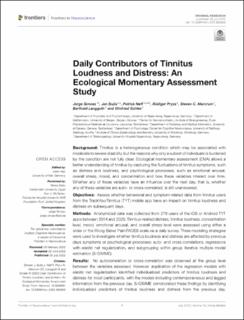| dc.description.abstract | Background: Tinnitus is a heterogeneous condition which may be associated with moderate to severe disability, but the reasons why only a subset of individuals is burdened by the condition are not fully clear. Ecological momentary assessment (EMA) allows a better understanding of tinnitus by capturing the fluctuations of tinnitus symptoms, such as distress and loudness, and psychological processes, such as emotional arousal, overall stress, mood, and concentration and how these variables interact over time. Whether any of those variables have an influence over the next day, that is, whether any of these variables are auto- or cross-correlated, is still unanswered.
Objectives: Assess whether behavioral and symptom-related data from tinnitus users from the TrackYourTinnitus (TYT) mobile app have an impact on tinnitus loudness and distress on subsequent days.
Methods: Anonymized data was collected from 278 users of the iOS or Android TYT apps between 2014 and 2020. Tinnitus-related distress, tinnitus loudness, concentration level, mood, emotional arousal, and overall stress level were assessed using either a slider or the Wong-Baker Pain FACES scale via a daily survey. Three modeling strategies were used to investigate whether tinnitus loudness and distress are affected by previous days symptoms or psychological processes: auto- and cross correlations, regressions with elastic net regularization, and subgrouping within group iterative multiple model estimation (S-GIMME).
Results: No autocorrelation or cross-correlation was observed at the group level between the variables assessed. However, application of the regression models with elastic net regularization identified individualized predictors of tinnitus loudness and distress for most participants, with the models including contemporaneous and lagged information from the previous day. S-GIMME corroborated these findings by identifying individualized predictors of tinnitus loudness and distress from the previous day.
Discussion: We showed that tinnitus loudness and tinnitus distress are affected by the contemporaneous and lagged dynamics of behavioral and emotional processes measured through EMA. These effects were seen at the group, and individual levels. The relevance EMA and the implications of the insights derived from it for tinnitus care are discussed, especially considering current trends toward the individualization of tinnitus care. | en_US |

